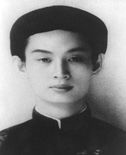PHẬT GIÁO HÒA HẢO
HARMONY BUDDHISM
Thần Tú
Thần Tú: Thần Tú (zh. shénxiù 神秀, ja. jinshū), ~ 605-706, cũng được gọi là Ngọc Tuyền Thần Tú, là thiền sư Trung Quốc, một trong những môn đệ xuất sắc của Ngũ tổ Hoằng Nhẫn. Theo truyền thuyết, sư thua cuộc trong việc chọn người nối pháp của Hoằng Nhẫn và Huệ Năng được truyền y bát. Sư vẫn tự xem mình là người nối pháp của Hoằng Nhẫn và sáng lập Bắc tông thiền, một dòng thiền vẫn còn mang đậm sắc thái Ấn Độ với bộ kinh Nhập Lăng-già làm căn bản.
Sư thuở nhỏ đã thông minh hơn người. Ban đầu, sư học Nho giáo nhưng không hài lòng, sau đó (năm 46 tuổi) đến núi Hoàng Mai nhập hội của Hoằng Nhẫn. Nơi đây, sư là môn đệ xuất sắc của Ngũ tổ (Sử sách có ghi lại tên của 11 người đệ tử của Hoằng Nhẫn đã giáo hoá danh tiếng). Sau khi Hoằng Nhẫn viên tịch, sư rời Hoàng Mai và đi du phương gần 20 năm. Sau, khi Vũ Hậu là Võ Tắc Thiên mời đến kinh đô, sư chần chừ rồi nhận lời. Nơi đây, sư giáo hoá rất nhiều người, danh tiếng lừng lẫy.
Năm Thần Long thứ hai (706), sư viên tịch. Vua sắc phong là Đại Thông Thiền sư. Đến giữa thế kỉ 8, vương triều công nhận sư là người thừa kế Ngũ tổ, nhưng dòng Thiền của sư tàn lụi sau vài đời, có lẽ vì liên hệ chính trị nhiều với vương triều.
Yuquan Shenxiu
Yuquan Shenxiu (Chinese: 玉泉神秀; pinyin: Yùquán Shénxiù; Wade–Giles: Yü-ch'üan Shen-hsiu, 606?–706) was one of the most influential Chan masters of his day, a Patriarch of the East Mountain Teaching of Chan Buddhism. Shenxiu was Dharma heir of Daman Hongren (601–674), honoured by Wu Zetian (r. 690–705) of the Tang dynasty, and the putative author of the Guan Xin Lun (Treatise on the Contemplation of the Mind, written between 675–700), a text once attributed to Bodhidharma.
Shenxiu was born in Weishi County, suburb of Luoyang, Henan, then secondary capital of China. His family name was Li. His family was aristocratic and may have been related to the Tang Dynasty imperial family. He was educated in the Chinese classics and Taoism and became a Buddhist at the age of thirteen when he went to the government granaries at Kaifeng during a famine to plead the release of grain to the starving population. There he met an unnamed Buddhist and was inspired to take up Buddhism. After some seven years of a homeless life visiting the famous mountain centres of China, Shenxiu took the full precepts of Buddhist monk in 625 at Tankong monastery in Luoyang(洛阳), the Buddhist centre at the end of Silk Road since the second century.
Traces of his activities for the next twenty-five years were lost, the Chuan Fabao Ji (傳法寶紀) (Annals of the Transmission of the Dharma-treasure) claim that Shenxiu studied the Buddhist regulations (vinaya) and ceremonies and devoted himself to the practice of meditation (dhyāna) and the development of wisdom (prajñā). In 651 he began to study under Hongren. The aforementioned Chuan Fabao Ji states that he studied with Hongren for six years, thereby leaving in 657, before the arrival of the Sixth Patriarch, Huineng, with whom Shenxiu supposedly had the famous verse-writing contest. (see below)
Open Wikipedia

